Bilbao, Basque Country 作者: 来源: 发布时间:2021-03-16
1. Population and Area
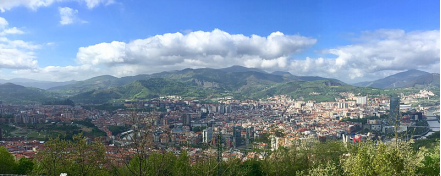
Pop: 1,037,847 (metro area)
Area: 41.50 km2 (munip.)
Elev: 19 masl
Bilbao location in Spain within the Basque Country community
https://goo.gl/maps/GG9kpTdyLqy4CghBA
2. Natural geography
Nature and weather
Hydrology
The main river system of Bilbao is also the hydrological artery of Biscay. The rivers Nervión and Ibaizabal converge in Basauri and form an estuary named variously "estuary of Bilbao", "of the Nervión", "of the Ibaizabal", or "of the Nervión-Ibaizabal". The estuary runs for 15 kilometres (9.3 mi) and with a low flow (with an average of 25 m3 (883 cu ft) per second). Its main tributary is the river Cadagua, which rises in the Mena valley and has a basin of 642 square kilometres (248 sq mi), mostly lying in the neighboring province of Burgos. This river is also the natural border between Bilbao and Barakaldo.
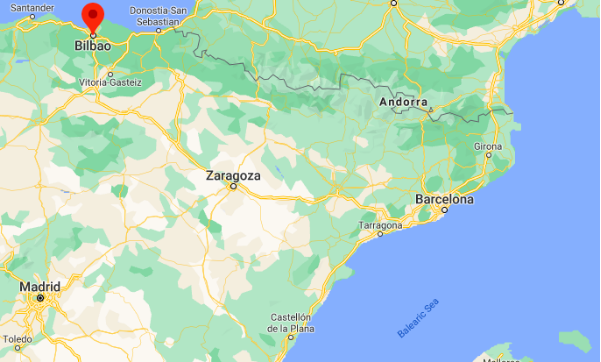
The river has frequently suffered from human intervention, as seen in the dredging of its bottom, the building of docks on both banks and especially in the Deusto canal, an artificial waterway dug between 1950 and 1968 in the district of Deusto as a lateral canal, with the aim of facilitating navigation, sparing ships from the natural curves of the estuary. The project was stopped with 400 metres (1,300 ft) left to complete, and it was decided to leave it as a dock. However, in 2007, a plan was approved to continue the canal and form the island of Zorrozaurre. This human intervention has also brought negative results in the quality of the water, after decades of toxic waste dumping causing a situation of anoxia (lack of oxygen), which almost eliminated the entire fauna and flora. However, in recent years this situation is being reversed, thanks to a dumping ban and natural regeneration. now it is possible to observe algae, tonguefishes, crabs, and seabirds, as well as occasional bathers in the summer months.
The estuary is also a natural border for several neighborhoods and districts within the borough. Entering the municipality from the west it separates the districts of Begoña and Ibaiondo, then Abando and Uribarri and lastly Deusto and Basurto-Zorroza.
Flora and fauna
The pottok: they are the small horses of the Basque Country. In its mountains you will surely cross paths with them (pronounced: potiok).
This peculiar breed that only exists in our region could be the descendant of a prehistoric horse. He is fully adapted to life in the mountains. For a long time, this little horse was used in agriculture and mining.
The pottok is a docile and generous animal yet it is a wild animal.
The Manex sheep: In the Basque Country a particular breed of sheep called Manex (pronounced manech) is raised.
It is recognized by its black head and its twisted horns on the skull.
Its milk is used essentially to produce "ardi gasna" (sheep's cheese).
The Betisoak: wild cows
On the slopes of the Rhune, you may come across the Betisoak, which are wild cows that live freely on the mountain.
Their fur is white / gray, they have impressive horns and they live in herds.
The birds of prey: during your walks, do not hesitate to look up to see the birds of prey that inhabit our region. In this way you can discover hawks, shoplifters, crows and even vultures.
It is true that "the Basque Country is green" as it houses the essences of particular plants and trees:
·blue chicory
·the wild rose
·bastard chamomile
·the crythmée and its pleasant smell of lemon balm
·american oak
·brown
·birch.
http://www.urrugne-tourisme.com/es/naturaleza/la-fauna-y-la-flora.html
Köppen Classification: Marine West Coast Climate
This area is characterized by equable climates with few extremes of temperature and ample precipitation in all months. It is located poleward of the Mediterranean climate region on the western sides of the continents, between 35° and 60° N and S latitude. Unlike their equatorial neighbors, marine west coast climates are located beyond the farthest poleward extent of the subtropical anticyclone, and they experience the mid-latitude westerlies and traveling frontal cyclones all year. Precipitation totals vary somewhat throughout the year in response to the changing location and intensity of these storm systems, but annual accumulations generally range from 500 to 2500mm (20 to 98 inches), with local totals exceeding 5000mm (197 inches) where onshore winds encounter mountain ranges. Not only is precipitation plentiful but it is also reliable and frequent. Many areas have rainfall more than 150 days per year, although the precipitation is often of low intensity. Fog is common in autumn and winter, but thunderstorms are infrequent. Strong gales with high winds may be encountered in winter. Temperatures in the winter tend to be mild, while summer temperatures are moderate.
The Köppen Climate Classification subtype for this climate is "Cfb". (Marine West Coast Climate).
The average temperature for the year in Bilbao is 57.7°F (14.3°C). The warmest month, on average, is August with an average temperature of 68.5°F (20.3°C). The coolest month on average is January, with an average temperature of 48.2°F (9°C).
The highest recorded temperature in Bilbao is 108.0°F (42.2°C), which was recorded in July. The lowest recorded temperature in Bilbao is 21.0°F (-6.1°C), which was recorded in January.
The average amount of precipitation for the year in Bilbao is 47.0" (1193.8 mm). The month with the most precipitation on average is November with 5.5" (139.7 mm) of precipitation. The month with the least precipitation on average is July with an average of 2.4" (61 mm). There are an average of 128.0 days of precipitation, with the most precipitation occurring in January with 13.0 days and the least precipitation occurring in July with 7.0 days.
In terms of liquid precipitation, there are an average of 172.0 days of rain, with the most rain occurring in April with 17.0 days of rain, and the least rain occurring in September with 11.0 days of rain.
http://www.weatherbase.com/weather/weather-summary.php3?s=52080&cityname=Bilbao%2C+Basque+Country%2C+Spain&units=
Getting there and around
Get there
By plane – Bilbao Airport (IATA: BIO) is served by Lufthansa, Air France, TuiFly, AerLingus, Iberia, Air Europa, Vueling, Norwegian and several other airlines. Easy Jet flies from London Stansted and Manchester to Bilbao airport. You can also fly with Ryanair to Santander.
To get to downtown from the airport, take Bizkaibus A3247 from outside the arrivals hall. From Bilbao, they leave every 30 minutes from 05:25 to 21:55; from the airport, every 30 minutes, from 06:15 to 23:15 (last departure at 0:00). The trip takes about 25 minutes. The bus makes three stops on the way: at Gran Via 79 Viajes Ecuador, Plaza Moyua and Almeda Recalde 11. A single ticket costs €3.00.
Taxis to downtown Bilbao from the airport cost about €25-30.
Biarritz Airport (IATA: BIQ) Is about an hour and half drive to the east of the city and is a popular airport for visitors from France. There are buses between Biarritz and San Sebastian and train that involve at least one change. Once in San Sebastian you can take a PESA bus to Bilbao. For more convenient travel use Airport Transfers for private transfers from Bilbao to any where you want to go.
By boat – A direct car ferry is available between Bilbao and Portsmouth, England. It is best to book early, since the ferry is often booked out in summer.
By train – RENFE-- runs intercity trains to Madrid, Barcelona, Vigo (Galicia). All Renfe trains leave from Abando Station.
FEVE -- runs regional trains to Santander (3 daily), and Leon (1 Daily). They are very slow, and make a stop in almost every single town they pass through. From Santander you can continue to Oviedo (Asturias), and La Coruña (Galicia). This journey has three legs, but it is only possible to do 2 legs in any one day. FEVE trains leave from Santander Station (next to Abando Station)
EuskoTren -- runs a local service to San Sebastian, with connection there for Irun (on the Spanish French border). It takes two hours to reach San Sebastian. Trains leave from Atxuri Station.
By bus – All buses to other provinces leave from the TermiBus terminal. There are regular connections to Santander (75 minutes) San Sebastian (60 minutes) and Madrid (arriving at Avenida de Las Americas bus station, 4-5 hours) among others.
To get in from San Sebastián, the PESA and ALSA buses take off from the main bus station. In Google maps you can type in 'Estación de Autobuses de San Sebastián, San Sebastian, Espana' to see where it is. You also need to buy a ticket from the PESA or ALSA ticket office before you board as you can't buy tickets walking onto the bus.
The bus companies connect Bilbao with many cities in Spain more cheaply and frequently than the rail companies.
The company linking Bilbao to Santander is ALSA (tel: +34 902 422 242), and in theory you can get info about buses from Santander to Bilbao at. Be prepared for long waiting lines of half an hour as there are only two ticket offices. It's usually better to buy the ticket the day before or print your ticket on the company's website. Instead of printing, you can also use the text message they send to your mobile as proof of purchase.
For Vitoria-Gasteiz, take La Unión Alavesa buses.
Rideshare – Check out Blabla Car's carpooling service for rideshare options. A great option if you don't have a driver's license or want to avoid public transport.
COVID19 – International entry into Spain: partially open
Non-essential travel is open with certain safety requirements. 1.5m social distancing and use of masks are mandatory within Spain.
Some COVID-19 travel conditions may apply in Spain and transport services are subject to change.
Get around
By car – Bilbao is difficult to drive in. Hilly one-way streets, and frequent construction projects, make it a nightmare for drivers in parts of the city. Having an automobile map helps a lot; without it allow at least 30min extra to find the right exit from the city. A good idea is to park at the Termibus car park (A-8 Exit 117) and take the tram from San Mamés station to where you want to go.
Public transport – If you are going to take more than one or two journeys on public transit, a Barik card would be a good investment. It can save you up to 50% over buying single tickets. It is valid on all the municipal transit systems in Bilbao (underground "Metro", short distance trains "cercanias", local bus "Bilbobus", province bus "Bizkaibus", Funicular to Artxanda and others, including the Bizkaia bridge). It is a stored-value contactless card available at all Metro stations, it cost 3€ and can be recharged at metro stations, usually in amounts of 5€. Individual tickets cost from €1.20 upward.
MetroBilbao: convenient, Norman Foster designed Metro. Single line within Bilbao, splitting into two lines after San Inazio station. Line one runs from Etxebarri to Plentzia; line two from Etxebarri to Santurtzi. Trains run every couple of minutes at peak hours. Tickets cost from €1.40-1.60, depending on how many zones your journey covers, or a daily card is available for €4.
Bilbobus City bus service.
EuskoTran: a green tram from Atxuri Station to Basurto. The single line runs along the river passing the Bilbao Guggenheim Museum. Single tickets cost €1.15 and are sold from machines at tram stops. Don't forget to validate the ticket before boarding.
EuskoTren local train service leaves from Atxuri Station for Bermeo, Guernica/Gernika and San Sebastian (Donostia). Some good views but the train is slower than buses.
BizkaiBus: for buses which operate outside Bilbao city limits. BizkaiBus runs a service between the bus terminal and the airport, with several stops in between and one in Plaza Moyua (Hacienda building). Other Bizkaibus destinations are Mundaka, Bakio, Gernika.
Artxanda Funicular Spectacular views of Bilbao.
Uber is expanding rapidly across Spain and now offers services in cities across the country. Uber has almost every Spanish city in its network every year, check for availability when you arrive at your destination. Beat, Cabify and Didi are also developing and currently operate in cities including Madrid, Barcelona, Valencia, Valladolid, Murcia, and Bilbao. Check for availability in the city you are visiting.
These services offer people with smartphones a way to book a cab through a mobile app for a pre-agreed price. Fares are comparable with Sitio type cabs, and sometimes trade at a premium to this when local demand increases.
Bicycle – Due to the demands of bicycle hire companies, the city's bike share system 'Bicing' is not available to tourists. Therefore, maybe consider walking instead. However, there are also several private bike rental services.
https://wikitravel.org/en/Bilbao
3. GDP
GDP: 36,900 M USD (2015, metro area)
4. Industry characteristics
The Bilbao metropolitan area comprises about 47% of the total population of the Basque autonomous community, out of which a 15% is registered in the municipality of Bilbao. The comarca of Greater Bilbao, in which the city occupies a central position, has a GDP per capita of €30,860, higher than the Spanish and European Union averages. The Bilbao metropolitan area has a nominal GDP amounting to $36,9 billion. Bilbao has been the economic centre of the Basque autonomous community since the original establishment of the Consulate of the Sea in the city in the 16th century, mostly thanks to the commerce in Castilian products on the town's port. It was in the 19th century when the city experimented its biggest economic development, mainly based on the exploitation of the nearby iron mines and siderurgy, both of which promoted maritime traffic and port activity and eventually the development of a very important shipbuilding industry.
Banking
Banking became an important sector with the establishment of the Bank of Bilbao (Spanish: Banco de Bilbao) in 1857 and the Bank of Biscay (Spanish: Banco de Vizcaya) in 1901. These two entities merged in 1988 creating the BBV, which finally merged with Argentaria bank in 1999, creating the current multinational corporation, the BBVA. The savings banks that were established locally, the Municipal Savings Bank of Bilbao (Spanish: Caja de Ahorros Municipal de Bilbao) in 1907 and the Provincial Savings Bank of Biscay (Spanish: Caja de Ahorros Provincial de Vizcaya) in 1921, would merge in 1990 to form the Bilbao Bizkaia Kutxa (BBK), which would merge again in 2012 with other Basque financial entities (Kutxa and Caja Vital Kutxa) to form Kutxabank. There is also the Chamber of Commerce, Industry and Navigation of Bilbao and the Stock Exchange Market of Bilbao, founded in 1890.
Port
The historical port was located in what is today an area called the Arenal, a few steps from the old city, until the late 20th century. In 1902, an exterior port was built at the mouth of the estuary, in the coastal municipality of Santurtzi. Further extensions to the outer port, which became called "the super-port", led to the final move of the city portuary facilities in the 1970s, finally replacing the docks in the centre of the city, with the exception of those located in the neighbourhood of Zorrotza, still active.
The port of Bilbao is a first-class commercial port and is among the top five of Spain.[106] Over 200 regular maritime services link Bilbao with 500 ports worldwide. At the close of 2009 cargo movements amounted to 31.6 million tonnes, Russia, the United Kingdom, the Netherlands and the Nordic countries being the main markets. In the first semester of 2008, it received over 67,000 passengers and 2,770 ships. This activity contributed 419 million euros to the Basque GDP and maintains almost 10,000 jobs.
Mining and ironworks
Iron is the main and most abundant raw material found in Biscay, and its extraction has been legally regulated since 1526. Mining was the main primary activity in Bilbao and the minerals, of great quality, were exported to all over Europe. It was not until the second half of the nineteenth century that an ironworks industry was developed, benefiting from the resources and the city's good communication links. In the 20th century, both Spanish and European capitals imported around 90% of the iron from Biscay. Although World War I made Bilbao one of the main ironworks powers, a subsequent crisis prompted a decline in the activity.
Tourism
The first notion of Bilbao as a tourist destination came with the inauguration of the railway between Bilbao and the coastal neighbourhood of Las Arenas, in the municipality of Getxo in 1872. The connection made Bilbao a minor beach destination.
The real tourist surge though would come much later with the inauguration of the Guggenheim Museum Bilbao in 1997. Thereafter tourist arrivals registered a continued upward trend, reaching over 932,000 visitors in 2018. The trend was exponential considering that in 1995, Bilbao only counted 25,000 tourists. Bilbao also hosts 31% of the total Basque Country visitors, being the top destination of this autonomous community, outranking San Sebastián. The majority of tourists are domestic visitors, coming from Madrid and Catalonia. International travellers are predominantly French, crossing the border just to the east. The others arrive from the United Kingdom, Germany, and Italy. Tourism generates about 300 million euros yearly for the Biscayan GDP. Bilbao also draws business tourism, having been equipped with facilities like the Euskalduna Conference Centre and Concert Hall, and the Bilbao Exhibition Centre, in nearby Barakaldo.
Stock exchange
Plans to create a stock exchange market in Bilbao began in the early 19th century, even though it would not be realized until 21 July 1890. Bilbao's institution is one of the country's four regional stock exchanges, joining Barcelona, Madrid, and Valencia as Spain's commercial centres. It is owned by Bolsas y Mercados Españoles. The Bilbao Stock Exchange is considered a secondary market.
Key project: AS-FABRIK project
AS Fabrik Bilbao aims to improve the competitiveness of local companies and consolidate Zorrotzaurre as an innovative and benchmark ecosystem in the field of advanced services for Industry 4.0 and the digital economy.
For this, the project will have as its epicenter a public building located in Zorrotzaurre with an industrial past, which will be set up as a reference center for the project and a meeting point for the planned activities. From this building, four key actions will be coordinated, to be carried out in the next three years, and whose objective is to contribute to the consolidation of a new production model:
Training programs aimed at university students, entrepreneurs and professionals, designed to address the challenges of Industry 4.0 in the digital economy.
Networking actions between the main agents or interest groups in the public and private spheres to coordinate a unique strategy that is effective and efficient to meet the current and future needs of the industrial sector.
Proposals that stimulate and favor the launch of Bilbao-based start-ups, related to technology, specialization and intelligence that Industry 4.0 requires to position itself internationally.
The implementation of an observatory and laboratory of ideas, where trends in the technological fields, industry 4.0 and the digital economy will be analyzed, to identify the challenges faced by local companies and propose innovative solutions for these challenges.
Thus, an ecosystem of talent and innovation is created in Bilbao, which will contribute to the development of local knowledge-intensive services companies and the promotion of the industrial sector, which must be actively involved in a process of intelligent transformation in order to ensure its future.
AS Fabrik Bilbao has a global budget of 5,807,642 euros, of which 80% -4,600,000- will be covered with a grant approved by the European Commission, through the Regional Development Fund (ERDF), after competing with 378 other proposals, among which only 20 have been selected.
https://www.bilbao.eus/cs/Satellite?cid=1272997878399&language=es&pageid=1272997878399&pagename=Bilbaonet%2FPage%2FBIO_contenidoFinal
5. Attractions
Guggenheim Museum Bilbao
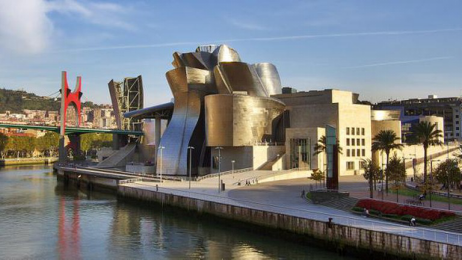
The Guggenheim Bilbao is a museum of modern and contemporary art designed by Frank Gehry. The museum is inaugurated on 18 October 1997 by King Juan Carlos I of Spain, with an exhibition of 250 contemporary works of art. Built alongside the Nervion River, which runs through the city of Bilbao to the Cantabrian Sea, it is one of several museums belonging to the Solomon R. Guggenheim Foundation and features permanent and visiting exhibits of works by Spanish and international artists. It is one of the largest museums in Spain.
One of the most admired works of contemporary architecture, the building itself has been hailed as a "signal moment in the architectural culture", because it represents "one of those rare moments when critics, academics, and the general public were all completely united about something", according to architectural critic Paul Goldberger. The museum was the building most frequently named as one of the most important works completed since 1980 in the 2010 World Architecture Survey among architecture experts.
The museum notably houses "large-scale, site-specific works and installations by contemporary artists", such as Richard Serra's 100-meter-long (340 ft) Snake, and displays the work of Basque artists, "as well as housing a selection of works" from the Foundation's modern art collection. In 1997, the museum opened with "The Guggenheim Museums and the Art of This Century", a 300-piece overview of 20th-century art from Cubism to new media art. Most pieces came from the Guggenheim's permanent collection, but the museum also acquired paintings by Willem de Kooning, Mark Rothko and Clyfford Still and commissioned new works by Francesco Clemente, Anselm Kiefer, Jenny Holzer and Richard Serra.
Bilbao Cathedral
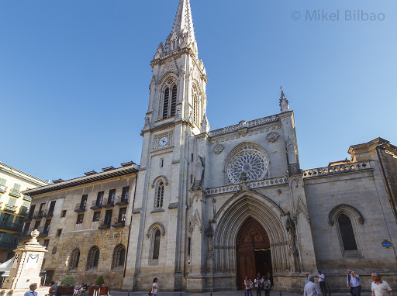
Consecrated to the Apostle Santiago, official patron of the city, the Basilica Cathedral of Bilbao is a beautiful Gothic temple built between the last quarter of the 14th century and the beginning of the 15th century. Its exterior shows neo-Gothic influences as a result of the deep reconstruction of the facade and the tower in the 19th century.
“The Cathedral Basilica of Santiago was declared a Historical and Artistic Heritage of Spain in 1931 and is considered one of the best Gothic manifestations in the Basque Country. "
When accessing its interior you can see its balanced Latin cross floor plan with three small naves, but of great beauty. Its cozy Gothic cloister, its southern portal, the Main Chapel and the Puerta del Ángel, popularly known as Puerta de los Peregrinos, an example of the best flowery Gothic included in the pilgrimage itinerary of the Camino de Santiago along the coastline stand out. It is made up of a large number of consecrated chapels and in its crypt, even today, the remains of the original hermitage on which it was built can be seen.
The Cathedral Basilica of Santiago was declared a Historical and Artistic Heritage of Spain in 1931 and is considered one of the best Gothic manifestations in the Basque Country.
https://catedralbilbao.com/la-catedral
Ribera Market
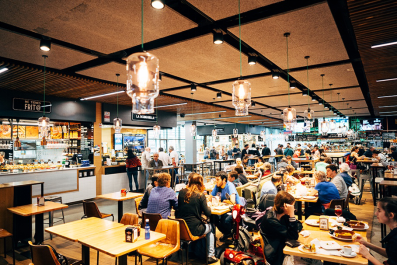
Ribera Market, located beside the river estuary in Bilbao, is a reference in terms of shopping for the whole of Biscay. One of its many merits is to have been recognized in 1990 as the most complete municipal food market by the Guinness Book of Records, at that time being the largest in terms of traders and stalls and the biggest covered market as regards space in the whole of Europe, with a surface area of 10,000 square metres.
Refurbishment work began en mid-2009 aimed at renewing its structure, stalls and services in order to remain a reference for shoppers in the 21st century. Not in vain, life and business have never stopped in this space where more than 60 merchants manage to provide customers with the finest produce at the best price: meat, fruit, shellfish, cheeses, cooked meats, frozen food, mushrooms and fungi.
https://www.bilbaoturismo.net/BilbaoTurismo/en/gastronomic-shopping/-ribera-market
Bilbao - Is this the best city in Spain?
https://youtu.be/PobXcrUzJBc
6. History
Pre-history
Remains of an ancient settlement were found on the top of Mount Malmasín, dating from around the 3rd or 2nd century BC. Burial sites were also found on mounts Avril and Artxanda, dated 6,000 years old. Some authors identify the old settlement of Bilbao as Amanun Portus, cited by Pliny the Elder, or with Flaviobriga, by Ptolemy.
Medieval Bilbao
Ancient walls, which date from around the 11th century, have been discovered below the Church of San Antón. Bilbao was one of the first towns founded in the fourteenth century, during a period in which approximately three-quarters of the Biscayan cities were developed, among them Portugalete in 1323, Ondarroa in 1327, Lekeitio in 1335, and Mungia and Larrabetzu in 1376. Diego López V de Haro, then third Lord of Biscay, founded Bilbao through a municipal charter dated in Valladolid on 15 June 1300 and confirmed by King Ferdinand IV of Castile in Burgos, on 4 January 1301. Diego López established the new town on the right bank of the Nervión river, on the grounds of the elizate of Begoña and granted it the fuero of Logroño, a compilation of rights and privileges that would prove fundamental to its later development.
In 1310 María Díaz I de Haro, niece of Diego López V and Lady of Biscay, grants a new municipal charter to the city, which extends its commercial privileges even further, transforming the city in a mandatory stop for all the trade coming from Castile towards the sea. This second charter established that the road from Orduña to Bermeo, at the time the most important trade route in the lordship, had to traverse the San Antón Bridge in Bilbao instead of the pass in Etxebarri, as it did until then. This strengthened the position of Bilbao as a trading post, in detriment of Bermeo, city which until then had acted as the main port of the territory. In addition, Bilbao was granted exclusive rights to all trade between the city and Las Arenas. In 1372, John I of Castile strengthened even more the city's position by naming Bilbao a free port and granting it special privileges concerning the trade of iron. This caused Bilbao to become an important port, particularly due to its trade with Flanders and Great Britain.
In 1443 the Church of Saint Anthony the Great was enshrined, having been built in the place of an old alcázar. Still today the church is one of the oldest extant buildings of the city. On 5 September 1483, the Queen Isabella I of Castile traveled to Bilbao to swear fealty to the fueros of Biscay. Her husband, Ferdinand II of Aragon had already done so in 1476 in Gernika.
Modern age
On 21 June 1511, Queen Joanna of Castile ordered the creation of the Consulate of the Sea of Bilbao. This would become the most influential institution of the borough for centuries, and would claim jurisdiction over the estuary, improving its infrastructure. Under the Consulate's control, the port of Bilbao became one of the most important of the kingdom. The first printing-press was brought to the town in 1577. Here in 1596, the first book in the Basque language was edited, entitled Doctrina Christiana en Romance y Bascuence by Dr. Betolaza.
In 1602 Bilbao was made the capital of Biscay, a title previously held by Bermeo. Around 1631, the city was the scenario of a series of revolts against the increased taxation on salt, which had been ordered by the Crown, an event locally known as the "Machinada of the salt". The revolt ended with the execution of several of its leaders. The city had seen a continuous increase of its wealth, especially after the discovery of extensive iron deposits in the surrounding mountains, and by the end of the century it managed to overcome the economic crises that affected the rest of the kingdom, thanks in part to the increased trading of wool (which now used the port of Bilbao instead of the one in Santander), and to the iron ore and its commerce with England and the Netherlands.
Contemporary Bilbao
Napoleonic invasion and Carlist wars
The French invasion of Spain saw the occupation of several Basque cities, but Bilbao was not among them. The first open uprising against Napoleonic rule took place on 6 August 1808, a month after the Battle of Bailén. French troops sieged and sacked the city, alongside the neighbouring towns of Deusto and Begoña on 16 August. Beginning on February 1810, the city was under the command of Pierre Thouvenot, general of the French army and Baron of the Empire, who had become the head of the Military Government of Vizcaya, which included the three Basque provinces. Thouvenot intended to move forward with the plan of total annexation of the Basque provinces into France, but the Peninsular War and ultimately the Battle of Vitoria made those plans impossible.
The Basque Country was one of the main sites of battles during the First Carlist War, a civil war between supporters of the Spanish regent Maria Christina, known as liberals, and those of the late king's brother Carlos of Borbón, known as Carlists. The Carlists were particularly focused on capturing Bilbao, a liberal and economic bastion in northern Spain.[53] The Carlist general Tomás de Zumalacárregui tried to take the city during the Siege of Bilbao of 1835, but he was wounded during a battle near Begoña and died some time after in the town of Zegama. The next year, the city resisted a second siege during which the liberal general Baldomero Espartero defeated the Carlists in the Battle of Luchana.[54] The city was untouched by the Second Carlist War, which took place mostly in Catalonia, but was again an important scenario during the Third Carlist War; in April 1874 the city suffered a third siege which lasted two months.
Despite the warfare, Bilbao prospered during the nineteenth and twentieth centuries, when it rose as the economic centre of the Basque Country. It was during this time that the railway first arrived to the city and the Bank of Bilbao (which later would go on to become the BBVA) was founded, as well as the Bilbao Stock Exchange. Steelmaking industries flourished with the creation of many new factories, including the Santa Ana de Bolueta and the Altos Hornos de Vizcaya in 1902. The city was modernised with new avenues and walkways, as well as with new modern buildings such as the City Hall building, the Basurto Hospital and the Arriaga Theatre.[55] The population increased dramatically, from 11,000 in 1880 to 80,000 in 1900. Social movements also arose, notably Basque nationalism under Sabino Arana, which in the subsequent decades would grow to become the Basque Nationalist Party.
Civil war and Francoist dictatorship
The Spanish Civil War in Bilbao started with a number of small uprisings suppressed by the Republican forces. On 31 August 1936, the city suffered its first bombing, with a series of air bombs dropped by Nationalist airplanes. In September, the Nationalists distributed pamphlets threatening further bombing if the city did not give up, which finally took place on 25 September when German planes, in coordination with Francoist forces, dropped at least a hundred bombs on the city. In May 1937, the Nationalist army besieged the town. The battle lasted until 19 June of that year, when Lieutenant Colonel Putz was ordered to destroy all bridges over the estuary, and the troops of the 5th Brigade took the borough from the mountains Malmasin, Pagasarri, and Arnotegi.
With the war over, Bilbao returned to its industrial development, accompanied by steady population growth. In the 1940s, the city was rebuilt, starting with the bridges and by 1948, the first commercial flight took off from the local airport. Over the next decade, there was a revival of the iron industry, which became a strategic industrial sector in Spain, as a consequence of the economic model promoted by Francoism. The city received migrants from other Spanish regions looking to work in the iron industry. The demand for housing outstripped supply, and workers built slums on the hillsides. It was in this context that the first social movements arose and the strike of the Euskalduna shipyard in 1947 was the first one to take place during the Francoist dictatorship. In this environment of social repression, on 31 July 1959 the separatist organisation ETA was created from Basque nationalist movements. During the 1960s the city was the scenario of several urban projects, with the creation of new neighbourhoods like Otxarkoaga and the motorway to the French border. In June 1968 the University of Bilbao, the first public university, was established. It would later be integrated into the University of the Basque Country.
Democracy and urban renewal
After the end of Francoist Spain and the establishment of a constitutional monarchy, in a process known in Spain as the transition, Bilbao was able to hold democratic elections again. This time Basque nationalists rose to power. With the approval of the Statute of Autonomy of the Basque Country in 1979, Vitoria-Gasteiz was elected the seat of the government and therefore the de facto capital of the Basque Autonomous Community, although Bilbao was larger and more powerful economically. In the 1980s, several factors such as labor demands and the arrival of cheap labor from abroad led to a devastating industrial crisis.
On 26 August 1983 during the celebration of the local festivities known as Aste Nagusia, the estuary overflowed up to five metres in some areas due to the continuous raining, killing two persons and causing important destructions in the city's infrastructure, with a total economic cost that reached 60,000 million pesetas (around 360 million Euro).
Since the mid-1990s, Bilbao has been in a process of deindustrialization and transition to a service economy, supported by investment in infrastructure and urban renewal, starting with the opening of the Bilbao Guggenheim Museum (the so-called Guggenheim effect), and continuing with the Euskalduna Conference Centre and Concert Hall, Santiago Calatrava's Zubizuri, the metro network by Norman Foster, the tram, the Iberdrola Tower and the Zorrozaurre development plan, among others. Many officially supported associations such as Bilbao Metrópoli-30 and Bilbao Ría 2000 were created to monitor these projects.
7. Other Information: Anti-rumor Project
Bilbao City Council is participating in the European “anti-rumors” project “Communication for integration - C4I”, led by the Council of Europe and together with the cities of Amadora (Portugal), Barcelona (Spain), Bilbao (Spain), Botkyrka ( Sweden), Erlangen (Germany), Limerick (Ireland), Loures (Portugal), Lublin (Poland), Nuremberg (Germany), Patras (Greece) and Sabadell (Spain). http://pjp-eu.coe.int/web/c4i.
The project, framed in the European Anti-rumor strategy and inspired by the innovative project developed in the city of Barcelona, aims to create and strengthen social mobilization networks to counter negative stereotypes, clichés and false rumors that circulate about the immigration and cultural diversity, which can lead to discriminatory attitudes that make it difficult for society to interact and coexist. Other cities in the state such as Getxo, Tenerife or Fuenlabrada are also developing initiatives with these same objectives.
The main purpose is to improve coexistence in our municipality, combating stereotypes linked to foreign immigration in Bilbao, promoting democratic values and respect for diversity, detecting and working on the difficulties we encounter in coexistence to promote social cohesion .
Why fight stereotypes? because they are nothing more than unfair generalizations applied to a community, which are usually false or very imprecise and hinder the relationship between people.
Within the framework of this project, the City Council has designed a global “anti-rumor” strategy that identifies false rumors and stereotypes that exist around the foreign population, providing objective and truthful information on the situations identified. This local strategy is deployed at the district and neighborhood level, counting on the involvement of the social network and tries to especially influence certain groups such as the young population or the media.
The project is developed through training and awareness-raising actions with the active involvement of the citizens and the social entities of the municipality.
https://www.bilbao.eus/cs/Satellite?cid=1279137009670&language=en&pagename=Bilbaonet%2FPage%2FBIO_Listado
8. Contact Information
City Mayor: Juan Mari Aburto Rique
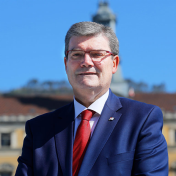
Phone number: +34 (944) 01 0010
Facebook: https://www.facebook.com/juanmariaburto
Twitter: https://twitter.com/juanmariaburto
Website: https://www.bilbao.eus
Govt. Office Address: Ernesto Erkoreka Plaza, 12, 48007 Bilbo, Bizkaia, Spain
